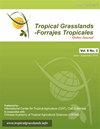Herbage yield and quality of 12 Urochloa cultivars and lines in Northeast Thailand
IF 0.7
4区 农林科学
Q3 AGRICULTURE, DAIRY & ANIMAL SCIENCE
引用次数: 0
Abstract
Forage accumulation yields and nutritive value of 12 Urochloa cultivars and pre-commercial lines (Mulato II, Cayman, Cobra, Marandu, Toledo, BRS Piatã, BRS Paiaguás, Ruzi, Humidicola, BRO4/3025, BRO4/3207 and BRO4/2515) were evaluated in a field trial in Northeast Thailand during 2015–2018. Total herbage yields for cultivars and lines over 3 years ranged from 15,800 kg DM/ha (Ruzi) to 33,800 kg DM/ha (Toledo). Toledo produced the highest total biomass across the 3 wet and dry seasons. BRS Piatã and BRS Paiaguás showed good performance, out-yielding Ruzi and Mulato II in total DM in both wet and dry seasons. The 6 hybrid Urochloa cultivars/lines (Mulato II, Cayman, Cobra, BRO4/3025, BRO4/3207 and BRO4/2515) all accumulated similar total DM yields over 3 years, outyielding Ruzi (P<0.05). Crude protein concentrations in forage were higher (P<0.05) in the dry season than wet season and in leaf than stem. In the second and third dry seasons, Ruzi had higher CP concentrations in both leaf and stem than all other cultivars and lines. ADF and NDF concentrations were lower in the dry season than the wet season. This trial has shown that BRS Piatá and BRS Paiaguãs would be ideal replacements for Mulato II and Ruzi in Northeast Thailand because of their superior dry season production for smallholder farmers for either cut-and-carry forage or grazing.泰国东北部12个Urochloa品种和品系的牧草产量和品质
2015-2018年,在泰国东北部进行了田间试验,评价了12个尾藻品种和预商品品系(Mulato II、Cayman、Cobra、Marandu、Toledo、BRS Piatã、BRS Paiaguás、Ruzi、Humidicola、BRO4/3025、BRO4/3207和BRO4/2515)的饲料积累产量和营养价值。品种和品系3年的牧草总产量从Ruzi的15800 kg DM/ha到Toledo的33800 kg DM/ha不等。托莱多在三个干湿季节产生了最高的总生物量。BRS Piatã和BRS Paiaguás表现优异,在旱季和湿季的总干物质产量均超过Ruzi和Mulato II。6个杂交种/品系(Mulato II、Cayman、Cobra、BRO4/3025、BRO4/3207和BRO4/2515) 3年DM总产量相近,高于Ruzi (P<0.05)。草料粗蛋白质含量旱季高于雨季(P<0.05),叶片高于茎干(P<0.05)。在第二和第三旱季,如子的茎叶CP含量高于其他品种和品系。旱季ADF和NDF浓度低于雨季。该试验表明,BRS piat和BRS paiagu将是泰国东北部Mulato II和Ruzi的理想替代品,因为它们的旱季产量对小农来说都很好,可以用于收割和运输牧草或放牧。
本文章由计算机程序翻译,如有差异,请以英文原文为准。
求助全文
约1分钟内获得全文
求助全文
来源期刊

Tropical Grasslands-Forrajes Tropicales
Agricultural and Biological Sciences-Agronomy and Crop Science
CiteScore
1.60
自引率
0.00%
发文量
36
审稿时长
16 weeks
期刊介绍:
The Journal publishes, in English or Spanish, Research Papers and Short Communications on research and development, as well as contributions from practitioners (Farmer Contributions) and Review Articles, related to pastures and forages in the tropics and subtropics. There is no regional focus; the information published should be of interest to a wide readership, encomprising researchers, academics, students, technicians, development workers and farmers.
In general, the focus of the Journal is more on sown (''improved'') pastures and forages than on rangeland-specific aspects of natural grasslands, but exceptions are possible (e.g. when a submission is relevant for a particularly broad readership in the pasture and forage science community).
The Journal will also consider the occasional publication of associated, but closely related, research in the form of an additional scientific communication platform [e.g. a re-make of the former Genetic Resources Communication series of the former Division of Tropical Crops and Pastures of the Commonwealth Scientific and Industrial Research Organisation (CSIRO), Australia].
Areas of particular interest to the Journal are:
Forage Genetic Resources and Livestock Production[...]
Environmental Functions of Forages[...]
Socio-economic Aspects[...]
Topics within the aforementioned areas may include: Diversity evaluation; Agronomy; Establishment (including fertilization); Management and utilization; Animal production; Nutritive value; Biotic stresses (pests and diseases, weeds); Abiotic stresses (soil fertility, water, temperature); Genetics and breeding; Biogeography and germplasm collections; Seed production; Ecology; Physiology; Rhizobiology (including BNF, BNI, mycorrhizae); Forage conservation; Economics; Multilocational experimentation; Modelling.
 求助内容:
求助内容: 应助结果提醒方式:
应助结果提醒方式:


